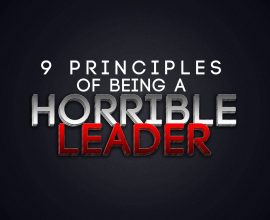Some people would call me a maverick or a rebel. I’ve been known to, and I often do things in unconventional ways. Some have called me innovative and have hired my services because they see my “out of the box” thinking as an asset. On the other hand, I’ve often been ostracized for being different or not doing things “the way they always have been done”. Either way, I think most people would say that I dislike boundaries.
The truth… I love boundaries.
The word “boundary” is a noun that means, “something that indicates limits”. I think often people think of “limits” as a bad thing. I deal with creative type people almost daily. I can’t tell you how many creative meetings I’ve been in that are absolutely pointless. You might ask, “How can a creative meeting be pointless?” You see, what will happen is a group of people will get into a room. The leader will read a synopsis or give a general direction and then say, “What do you think?” At that point, the people in the room begin throwing out any random thoughts they may have. 1 or 2 might be good. Most are absolutely horrible. Most of the time of the meeting is actually spent chasing rabbit trails and talking about things completely not pertaining to the subject matter. Some of you reading this may be thinking that this sounds like a good creative or free thinking process. I disagree. I call this chaos.
I believe when you give people boundaries to work between they then become even freer to be creative.
Imagine driving to work tomorrow morning. All of the sudden someone is in your lane driving directly toward you. What you didn’t realize is that over night, your local government did away with lanes and sides of the road. They opened it up for a “free drive” where you can drive wherever you want on or off the road and however you want. Now does that seem safe, or productive? No, it’s crazy. It’s complete chaos. I believe that creativity and life for that matter is the same way. If you direct people to their sides of the road, and then their lanes they become empowered to get to the destination in a safer and more effective manner.
A few suggestions for a productive meeting:
1. Invite only those that it is necessary for them to be there. Having people present for a meeting that aren’t necessary wastes their time and wastes the time of the other attendees because at some point the person that it isn’t necessary for them to be there is going to chime in and most of the time their input isn’t helpful.
2. Create a DETAILED agenda and get it to the attendees a minimum of 3 days in advance. When a leader doesn’t have a detailed agenda going into a meeting it is very easy for the meeting to get off course. When attendees don’t have a detailed agenda of the meeting they can’t be prepared and certainly can’t bring their best ideas/thoughts to the meeting. Ideally the attendees should have this agenda a week in advance to have adequate time to come up with their best possible ideas.
3. Put a time limit on the meeting and on the individual bullet points of the agenda. Time constraints put a little pressure on a situation. It forces the team to focus on only the best ideas and on being the most productive. If a time limit expires without a solution, it is “OK” to table the discussion to rethink and come up with better ideas.
4. Appoint someone who is the Time & Focus Keeper. Having someone that is focused on keeping everyone on task keeps the meeting focused and productive. It prevents wasted time and needless discussion. They have the authority to stop any story or discussion and put everyone back on task. They also have the authority to call “Time” on any discussion and/or the entire meeting. It is usually best if this individual is not the leader of the meeting.
5. After every meeting, gauge the productivity of the meeting. From the detailed agenda created you should be able to sit down post-meeting and judge if you accomplished what you wanted with the meeting. If you don’t measure the effectiveness of a meeting you will never know if you are truly being productive. If you measure the effectiveness and see that you’re not accomplishing what you want, in the way you want or in the time you want, this gives you a starting point to begin to determine what needs to be changed, whether it’s system, organization of meeting, the people in attendance, or perhaps your leadership. (Yup, I said it.)
Boundaries are healthy. I believe if you use them correctly you will become a better leader of a better team that’s more productive and makes your organization better.




